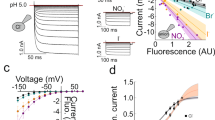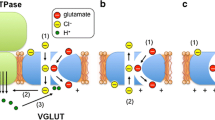Abstract
Previous work had demonstrated that organomercurial-mediated modification of two cysteine residues in the vesicular acetylcholine transporter (VAChT) from Torpedo californica inhibits binding of vesamicol. The cysteines are protected by acetylcholine and vesamicol (Keller et al. 2000. J. Neurochem. 74:1739–1748). Modified “cysteine 1” is accessible to glutathione from the cytoplasmic surface, whereas modified “cysteine 2” is not. Different organomercurials and aqueous environments were used here to characterize diffusion pathway(s) leading to the cysteines. para-Chloromercuriphenylsulfonate modifies VAChT much more slowly than do more hydrophobic p-chloromercuribenzoate and phenylmercury chloride. Permeabilization of vesicles with cholate detergent increases the rate of modification by p-chloromercuriphenylsulfonate. Permeabilization does not affect the ability of glutathione to reverse modification by p-chloromercuriphenylsulfonate. Higher ionic strength causes about four-fold increase in the rate of modification. The results suggest that hydrophobic and electrostatic barriers inhibit modification of Torpedo VAChT by negatively charged organomercurials and glutathione cannot reach cysteine 2 from either side of the membrane.
Similar content being viewed by others
REFERENCES
Keller, J. E., Bravo, D. T., and Parsons, S. M. 2000. Modification of cysteines reveals linkage to acetylcholine and vesamicol binding sites in the vesicular acetylcholine transporter of Torpedo californica. J. Neurochem. 74:1739–1748.
Gracz, L. M. and Parsons, S. M. 1996. Purification of active synaptic vesicles from the electric organ of Torpedo californica and comparison to reserve vesicles. Biochim. Biophys. Acta 1292:293–302.
Bradford, M. M. 1976. A rapid and sensitive method for the quantitation of microgram quantities of protein utilizing the principle of protein-dye binding. Anal. Biochem. 72:248–254.
Habeeb, A. F. S. A. 1972. Reaction of protein sulfhydryl groups with Ellman's reagent. Methods Enzymol. 25:457–464.
Rowland, R. L. 1952. Mercurial diuretics: VI. Ionization of organic mercurials. J. Am. Chem. Soc. 74:5482–5484.
Selwyn, M. J. 1972. Permeability effects of organomercurials. Biochem. J. 130:65p–67p.
Simpson, R. B. 1961. Association constants of methylmercury with sulfhydryl and other bases. J. Am. Chem. Soc. 83:4711–4717.
Vansteveninck, J., Weed, R., and Rothstein, A. 1965. Localization of erythrocyte membrane sulfhydryl groups essential for glucose transport. J. Gen. Physiol. 48:617–632.
Knauf, P. A. and Rothstein, A. 1971a. Chemical modification of membranes: I. Effects of sulfhydryl and amino reactive reagents on anion and cation permeability of the human red blood cell. J. Gen. Physiol. 58:190–210.
Knauf, P. A. and Rothstein, A. 1971b. Chemical modification of membranes: II. Permeation paths for sulfhydryl agents. J. Gen. Physiol. 58:211–223.
Hellman, B., Lernmark, A., Sehlin, J., Soderberg, M., and Taljedal, I. 1973. The pancreatic beta-cell recognition of insulin secretagogues: VII. binding and permeation of chloromercuribenzene-p-sulphonic acid in the plasma membrane of pancreatic beta-cells. Arch. Biochem. Biophys. 158:434–441.
Shapiro, B., Kollmann, G., and Martin, D. 1970. The diversity of sulfhydryl groups in the human erythrocyte membrane. J. Cell Physiol. 75:281–292.
Rothstein, A. 1970. Sulfhydryl groups in membrane structure and function. Curr. Top. Memb. Transp. 1:135–176.
Zhu, H., Duerr, J. S., Varoqui, H., McManus, J. R., Rand, J. B., and Erickson, J. D. 2001. Analysis of point mutants in the Caenorhabditis elegans vesicular acetylcholine transporter reveals domains involved in substrate translocation. J. Biol. Chem. 276:41580–41587.
Wilkinson, G., Stone, F. G. A., and Abel, E. W. eds. 1982. Comprehensive Organometallic Chemistry, Vol. 2, Pages 931–933, Pergamon Press, Oxford, New York.
Waugh, T. D., Walton, F. H., and Laswick, J. A. 1955. Ionization constants of some organomercuric hydroxides and halides. J. Phys. Chem. 59:395–399.
Merickel, A., Kaback, H. R., and Edwards, R. H. 1997. Charged residues in transmembrane domains II and XI of a vesicular monoamine transporter form a charge pair that promotes high affinity substrate recognition. J. Biol. Chem. 272:5403–5408.
Kim, M.-H., Lu, M., Lim, E.-J., Chai, Y.-G., and Hersh, L. B. 1999. Mutational analysis of aspartate residues in the transmembrane regions and cytoplasmic loops of rat vesicular acetylcholine transporter. J. Biol. Chem. 274:673–680.
Ripoll, D. R., Faerman, C. H., Axelsen, P. H., Silman, I., and Sussman, J. L. 1993. An electrostatic mechanism for substrate guidance down the aromatic gorge of acetylcholinesterase. Proc. Natl. Acad. Sci. USA 90:5128–5132.
Author information
Authors and Affiliations
Rights and permissions
About this article
Cite this article
Keller, J.E., Parsons, S.M. Diffusion Pathways to Critical Cysteines in the Vesicular Acetylcholine Transporter of Torpedo . Neurochem Res 28, 477–482 (2003). https://doi.org/10.1023/A:1022856919926
Issue Date:
DOI: https://doi.org/10.1023/A:1022856919926




